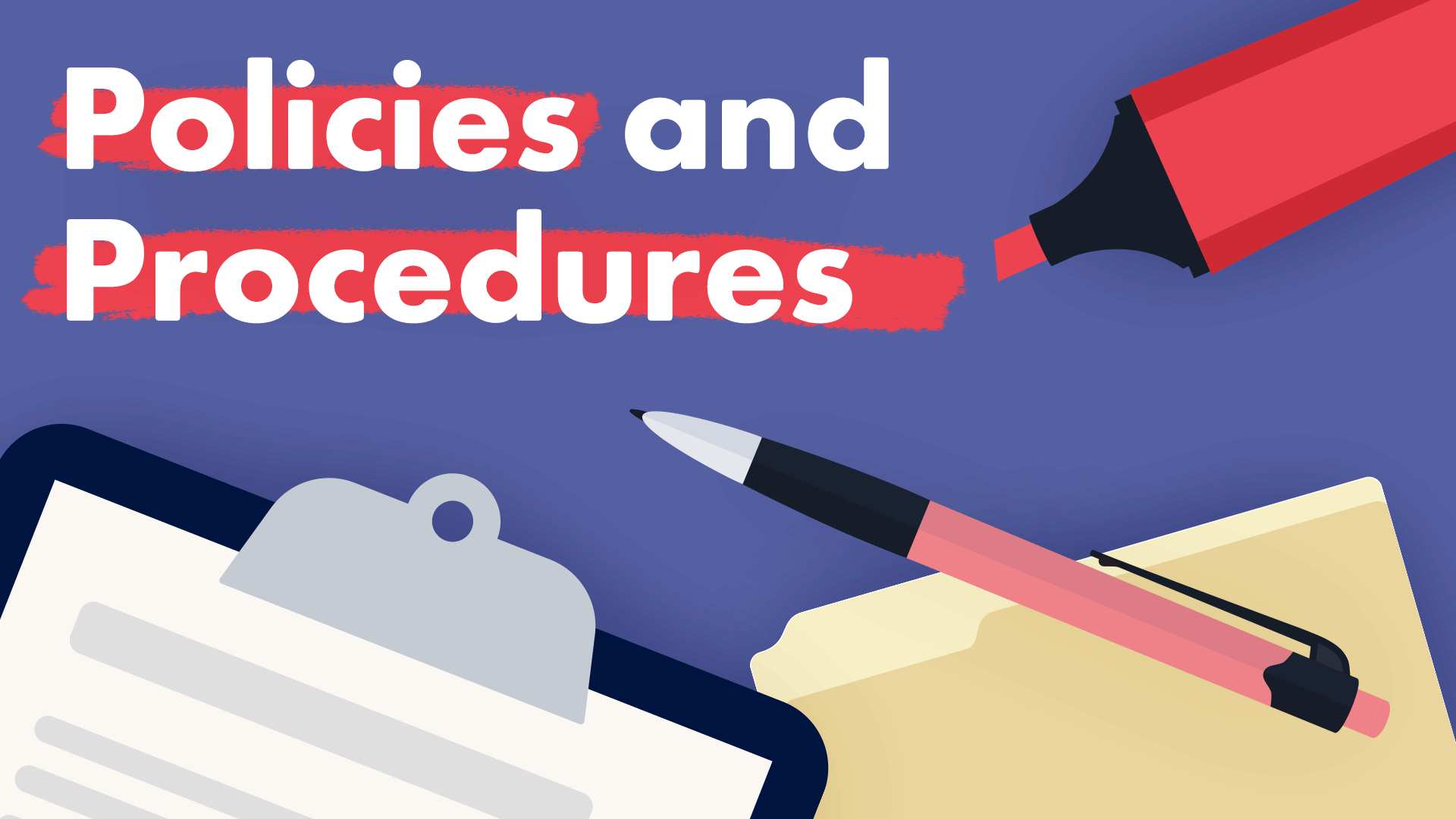‘Policies and procedures’ is the first component of Patient Safety and Quality Systems, as outlined by the National Safety and Quality Health Service Standards: Standard 1 Clinical Governance.
Patient Safety and Quality Systems
Purpose: Patient safety and quality systems are in place within governance processes to allow organisations to advance the safety and the quality of patients’ care (ACSQHC 2019).
Policy v Procedure: What’s the Difference?
Policies and procedures are the first things an organisation should establish in order to operate effectively.
Policies
Procedures provide step-by-step instructions for routine tasks and allocate people to be responsible for certain tasks. They should also make it clear which steps should be taken in common scenarios and who should be reported to. A checklist may be involved (PowerDMS 2020a).
Policies include:
- Employee entitlements and what they can expect from the organisation
- What the organisation expects from its employees
- What consumers and the community can expect from the organisation.
(PowerDMS 2020a)
Procedures
Procedures provide step-by-step instructions for routine tasks. They should also allocate people to be responsible for certain tasks. Procedures should make it clear which steps should be taken in common scenarios and who should be reported to. A checklist may be involved (PowerDMS 2020a).
Procedures may include:
- Handling complaints
- Documentation and handling healthcare records
- Managing patient aggression.
Policies and procedures are fundamental for consistency across an organisation, for both staff and consumers. They guide the organisation, influencing and determining all major decisions and actions, and reduce liability risks (PowerDMS 2020a).
Policies and procedures should be widely accessible and cover all activities carried out by the organisation. All policies should be laid out in the same format and should be written in common language that all staff members can comprehend (PowerDMS 2020b).

The Quality Systems planning process may involve steps such as:
- Establishing a policy team or group
- Identifying possible conflicts of interest
- Engaging with stakeholders
- Engaging with consumers
- Engaging Aboriginal and Torres Strait Islander people and diverse groups
- Analysing purpose and context
- Defining the scope of the policy or procedure
- Altering, adapting or starting from scratch
- Investigating:
- Transparency
- Implementability
- Equity.
(NHMRC 2019)
The implementation of a new policy should be followed by this process, at a minimum:
- Distributing policies and having all employees sign them
- Ensuring that staff are all trained on the new policy
- Monitoring the compliance and effectiveness of policies
- Establishing a policy review cycle.
(PowerDMS 2020b; NHMRC 2019)
Policies and Procedures in Healthcare
Policies and procedures are an incredibly important part of ensuring staff know how to care for patients and carry out tasks with confidence. Policies and procedures provide standardisation in everyday operational activities, which helps to foster consistency in practices, decrease mistakes, and keep both patients and staff safe (PowerDMS 2020b; RLDatix Marketing 2020).
The NSQHS Standards outline that a health service should manage risk in the following ways:
- By reviewing the effectiveness of policies, procedures and protocols
- By taking action to improve adherence to these systems
- By reviewing compliance with legislation, regulation and jurisdictional compliance.
(ACSQHC 2021)
Policies and procedures are particularly crucial in healthcare, an industry that is very familiar with crises. Healthcare organisations endure a high rate of liability risks. When appropriate policies and procedures are in place, an incident is easier to navigate (PowerDMS 2020a).
This is because procedures outline the actions that an employee and manager should take when an incident occurs. Additionally, reviewing policies, procedures and incident reports may help those in leadership positions to identify what went wrong and prevent incidents from reoccurring (PowerDMS 2020a).

Policy and Procedure Review
It cannot be overstated that policies and procedures must be constantly reviewed and updated. Healthcare standards and regulations are constantly fluctuating. At a minimum, these documents should be refreshed annually and each time a new law or regulation is put in place or updated (PowerDMS 2020b; RLDatix Marketing 2020).
Patient Involvement
In recent years, the notion of patient involvement in reviewing policies and procedures has gained traction. Both clinical and non-clinical committees should regularly review all policies and procedures (Armstrong & Bloom 2017).
Patient involvement is a relatively new concept and is yet to be embraced completely. This could be viewed as an opportunity wasted. Patient and public contributions to policy and procedure development can include:
- Evaluation of guideline priorities
- A re-focus towards holistic approaches to care
- Broaching new topics
- Identification of populations and outcomes
- Suggestions as to whether findings are meaningful or relevant
- Determining how or to what extent recommendations interact with patient values
- Prompting the use of common language within these documents.
(Armstrong & Bloom 2017)

Conclusion
Together, policies and procedures help ensure that a health service organisation's ethos and vision are communicated in tangible steps that lead to safe, high-quality healthcare.
Test Your Knowledge
Question 1 of 3
True or false: Employee entitlements should be covered by an organisation’s policies.
Topics
References
- Armstrong, MJ & Bloom, JA 2017, ‘Patient Involvement in Guidelines is Poor Five Years After Institute of Medicine Standards: Review of Guideline Methodologies’, Research Involvement and Engagement, vol. 3, no. 19, viewed 17 October 2024, https://researchinvolvement.biomedcentral.com/articles/10.1186/s40900-017-0070-2
- Australian Commission on Safety and Quality in Health Care 2021, National Safety and Quality Health Service Standards, 2nd edn, Australian Government, viewed 17 October 2024, https://www.safetyandquality.gov.au/publications-and-resources/resource-library/national-safety-and-quality-health-service-standards-second-edition
- Australian Commission on Safety and Quality in Health Care 2022, Patient Safety and Quality Systems, Australian Government, viewed 18 October 2022, https://www.safetyandquality.gov.au/standards/nsqhs-standards/clinical-governance-standard/patient-safety-and-quality-systems
- Clark, I 2016, Organizational Policies, Atlas of Public Management, viewed 17 October 2024, https://www.atlas101.ca/pm/concepts/organizational-policies/
- National Health and Medical Research Council 2019, Plan, Australian Government, viewed 17 October 2024, https://www.nhmrc.gov.au/guidelinesforguidelines/plan
- PowerDMS 2020a, What is a Policy vs. a Procedure?, PowerDMS, viewed 17 October 2024, https://www.powerdms.com/policy-learning-center/what-is-a-policy-vs.-a-procedure
- PowerDMS 2020b, Writing Policies and Procedures in Healthcare, PowerDMS, viewed 17 October 2024, https://www.powerdms.com/policy-learning-center/writing-policies-and-procedures-in-healthcare
- RLDatix Marketing 2020, ‘The Importance of Healthcare Policies and Procedures’, NA/ Global Blog, 27 July, viewed 17 October 2024, https://resources.rldatix.com/en-us-blog/the-importance-of-healthcare-policy-and-procedures
 New
New 
